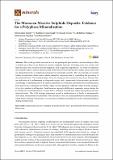Por favor, use este identificador para citar o enlazar a este item:
http://hdl.handle.net/10261/178939COMPARTIR / EXPORTAR:
 SHARE SHARE
 CORE
BASE CORE
BASE
|
|
| Visualizar otros formatos: MARC | Dublin Core | RDF | ORE | MODS | METS | DIDL | DATACITE | |

| Título: | The Moroccan Massive Sulphide Deposits: Evidence for a Polyphase Mineralization |
Autor: | Essaifi, Abderrahim; Goodenough, Kathryn; Tornos, F. CSIC ORCID ; Outigua, Abdelhak; Ouadjou, Abdelmalek; Maacha, Lhou | Palabras clave: | Polymetallic massive sulphide deposits Shear zones Geochemistry Moroccan Meseta Hercynian |
Fecha de publicación: | 6-mar-2019 | Editor: | Multidisciplinary Digital Publishing Institute | Citación: | Minerals 9(3): 156 (2019) | Resumen: | This work provides an overview of the geological, geochemical, and metallogenic data available up to date on the Moroccan massive sulphide deposits, including some new results, and then discusses the evidences for the epigenetic and syngenetic hypotheses. All of the ore deposits are located within a crustal block located at the intersection between two major shear zones and are characterized by a sustained and long-lived magmatic activity. The ore deposits are located within second-order shear zones, which played an important role in controlling the geometry of the mineralization. The mineralization lacks the unequivocal textural and structural features that are indicative of a sedimentary or diagenetic origin, and a syntectonic to late-tectonic pyrite-rich assemblage is superimposed on an earlier, pretectonic to syntectonic pyrrhotite-rich mineralization. Each deposit has a distinctive pyrrhotite sulfur isotopic signature, while the sulfur isotopic signature of pyrite is similar in all deposits. Lead isotopes suggest a shift from a magmatic source during the pyrrhotite-rich mineralization to a source that is inherited from the host shales during the pyrite-rich mineralization. The O/H isotopic signatures record a predominance of fluids of metamorphic derivation. These results are consistent with a model in which an earlier pyrrhotite-rich mineralization, which formed during transtension, was deformed and then remobilized to pyrite-rich mineralization during transpression. | Versión del editor: | http://dx.doi.org/10.3390/min9030156 | URI: | http://hdl.handle.net/10261/178939 | DOI: | 10.3390/min9030156 | E-ISSN: | 2075-163X |
| Aparece en las colecciones: | (IGEO) Artículos |
Ficheros en este ítem:
| Fichero | Descripción | Tamaño | Formato | |
|---|---|---|---|---|
| minerals-09-00156.pdf | 5,09 MB | Adobe PDF |  Visualizar/Abrir |
CORE Recommender
SCOPUSTM
Citations
9
checked on 19-abr-2024
WEB OF SCIENCETM
Citations
9
checked on 23-feb-2024
Page view(s)
231
checked on 18-abr-2024
Download(s)
292
checked on 18-abr-2024
Google ScholarTM
Check
Altmetric
Altmetric
Este item está licenciado bajo una Licencia Creative Commons

